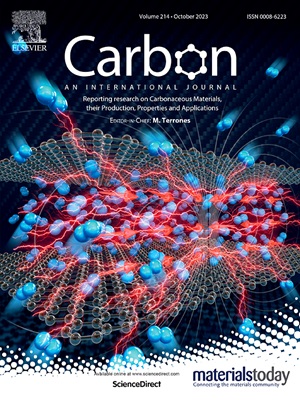无氢DLC/B4C周期纳米多层膜上石墨烯摩擦膜的形成:N2气氛溅射的影响
IF 10.5
2区 材料科学
Q1 CHEMISTRY, PHYSICAL
引用次数: 0
摘要
非晶类金刚石(DLC)涂层通常掺杂其他元素或发展为周期性纳米多层涂层(PNC)以提高摩擦性能。本研究制备了无氢DLC/B4C pnc,并对其力学性能和宏观摩擦学性能进行了研究。与其他涂层相比,DLC/B4C PNC的弹性指数(H/E)相当可观。在摩擦测试中,我们发现石墨烯片和各种类型的石墨薄片出现在磨损轨迹(堆积)和摩擦膜的边缘。这种现象以前没有报道过无h dlc基涂层。对于掺氮的PNC,硬度降低,而附着强度提高。摩擦实验表明,掺n的PNC的磨损率低于未掺n的PNC,而其摩擦系数(COF)更高。拉曼光谱显示石墨烯/石墨片不存在于堆积或摩擦膜中,这表明氮化抑制了石墨烯的形成。石墨烯/石墨摩擦膜的缺失和硬度的降低导致了更高的COF。本文章由计算机程序翻译,如有差异,请以英文原文为准。
Graphene tribofilm formation on hydrogen-free DLC/B4C periodical nano-multilayer coatings: Effect of sputtering in N2 atmosphere
Amorphous diamond-like carbon (DLC) coatings are usually doped with other elements or developed as periodical nano-multilayer coatings (PNC) to enhance tribological performance. In this study, hydrogen (H)-free DLC/B4C PNCs were fabricated, and their mechanical and macroscale tribological properties were investigated. The elasticity index (H/E) of the DLC/B4C PNC was considerable compared to other coatings. In friction tests, we discovered that graphene sheets and various types of graphite flakes developed at the edges of wear tracks (pile-ups) and tribofilms. This phenomenon has not been reported previously for H-free DLC-based coatings. For nitrogen (N)-doped PNC, the hardness decreased, whereas the adhesion strength improved. Friction experiments showed that the wear rate of N-doped PNC was lower than that of the undoped PNC, whereas its coefficient of friction (COF) was higher. Raman spectra revealed that graphene/graphite sheets were not present in the pile-ups or tribofilms, suggesting that nitridation inhibited graphene formation. The absence of the graphene/graphite tribofilms and the decreased hardness contributed to higher COF.
求助全文
通过发布文献求助,成功后即可免费获取论文全文。
去求助
来源期刊

Carbon
工程技术-材料科学:综合
CiteScore
20.80
自引率
7.30%
发文量
0
审稿时长
23 days
期刊介绍:
The journal Carbon is an international multidisciplinary forum for communicating scientific advances in the field of carbon materials. It reports new findings related to the formation, structure, properties, behaviors, and technological applications of carbons. Carbons are a broad class of ordered or disordered solid phases composed primarily of elemental carbon, including but not limited to carbon black, carbon fibers and filaments, carbon nanotubes, diamond and diamond-like carbon, fullerenes, glassy carbon, graphite, graphene, graphene-oxide, porous carbons, pyrolytic carbon, and other sp2 and non-sp2 hybridized carbon systems. Carbon is the companion title to the open access journal Carbon Trends. Relevant application areas for carbon materials include biology and medicine, catalysis, electronic, optoelectronic, spintronic, high-frequency, and photonic devices, energy storage and conversion systems, environmental applications and water treatment, smart materials and systems, and structural and thermal applications.
 求助内容:
求助内容: 应助结果提醒方式:
应助结果提醒方式:


